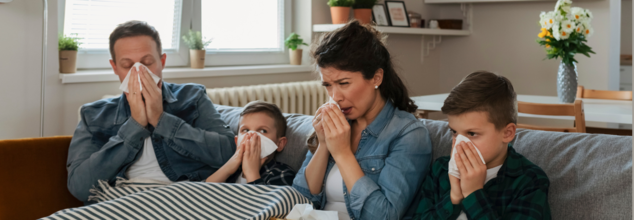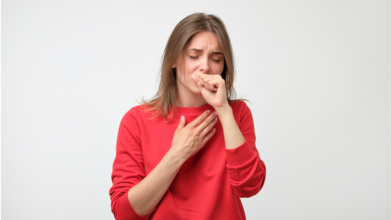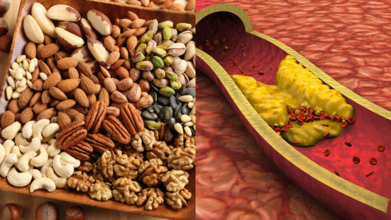- Health Conditions A-Z
- Health & Wellness
- Nutrition
- Fitness
- Health News
- Ayurveda
- Videos
- Medicine A-Z
- Parenting
- Web Stories
Flu Is Contagious, This Is How Long It Can Last

Image Credit: Canva
Influenza, commonly known as the flu, is a highly contagious viral infection that primarily affects the upper respiratory system, including the nose, throat, and lungs. Unlike the stomach flu, which causes nausea, vomiting, and diarrhea, influenza leads to fever, chills, body aches, and respiratory symptoms such as coughing and congestion. While most people recover within a week, complications can arise, particularly in vulnerable groups.
The Centers for Disease Control and Prevention attributes this sudden increase to reduced exposure to the virus during the COVID-19 pandemic, leading to lower immunity among the population. Data from the CDC revealed that by the end of November, only 40% of adults in the United States had been vaccinated, thus exposing most of them to dangerous infections and complications. The flu season this year has been especially virulent for several reasons: people's immunity levels have not reached their peaks, circulation of viruses has been more frequent and the percentage of vaccination rates is relatively low.
How the Flu Spreads?
The flu is transmitted through tiny droplets expelled when an infected person coughs, sneezes, or talks. These droplets can land directly on another person's mouth or nose, leading to infection. Additionally, the virus can survive on surfaces like doorknobs, remote controls and keyboards for several hours. When a healthy individual touches these contaminated surfaces and then touches their face, they risk contracting the virus. Given its ease of transmission, the flu can spread rapidly in crowded environments such as schools, offices, and public transportation.
How Long Does the Flu Last?
Symptoms of flu persist for different times in different persons, depending upon their health and whether they had been vaccinated or not. However, the typical duration is within one to four days of contact and five to seven days later. Some will have a slightly milder reaction and illness when vaccinated. While others will get better sooner; others may remain ill for weeks. After disappearance of symptoms, there may also be fatigue which lasts for another few days.
Certain individuals are at a higher risk of developing severe flu-related complications, including pneumonia. These high-risk groups include:
- Infants and young children
- Adults aged 65 and older
- Pregnant individuals
- People with chronic medical conditions (e.g., asthma, diabetes, heart disease or HIV)
- Those with a body mass index (BMI) of 40 or higher
For these populations, the flu can escalate into life-threatening conditions making early intervention and prevention crucial.
How Long Is the Flu Contagious?
One of the most concerning aspects of influenza is its contagious period. According to the Centers for Disease Control and Prevention (CDC), individuals with the flu are most contagious during the first 3 days of their illness. However, the contagious period begins a day before symptoms appear and can extend up to seven days or more, depending on the severity of the illness.
An infected person can pass the flu a day before they even begin to feel symptoms.
The highest risk of transmitting the virus occurs between days two and four when symptoms are at their worst.
Even after symptoms have subsided, people may still be able to spread the flu for up to a week.
For instance, for those who have weakened immune systems or severe forms of the flu this contagious period can be significantly longer explaining why caution is needed when there is contact with other people.
Flu Prevention
Because flu is contagious, its prevention is one way of handling a reduction in infections. From simple to effective measures, the risk of infection can greatly be reduced:
1. Vaccination
The annual flu shot is the most effective way to protect against influenza. While it doesn’t guarantee complete immunity, it significantly reduces the risk of infection and severity of symptoms.
2. Stay Home When Sick
If you develop flu symptoms, staying home is the best way to prevent spreading the virus to others. Avoid close contact with household members, especially those at high risk for complications.
3. Practice Good Hygiene
- Wash hands frequently with soap and water for at least 20 seconds.
- Use hand sanitizer when soap is unavailable.
- Cover coughs and sneezes with a tissue or the inside of your elbow.
- Avoid touching your face, especially your mouth, nose and eyes.
4. Disinfect Surfaces
Regularly clean and disinfect frequently touched objects, including phones, countertops and doorknobs, to minimize the risk of contamination.
5. Wear Masks in Public Spaces
Wearing a mask, especially in crowded indoor environments can help reduce the spread of flu viruses, particularly during peak flu season.
When to See a Doctor
While most people recover from the flu without medical intervention, there are instances when professional care is necessary. Individuals at high risk for complications should consult a doctor at the first signs of illness. Antiviral medications like Tamiflu may be prescribed to shorten the duration and severity of symptoms.
Seek emergency medical care if you or a loved one experiences:
- Difficulty breathing or shortness of breath
- Chest pain or pressure
- Dizziness, confusion or difficulty waking up
- Bluish lips or face
- Severe muscle weakness
- Symptoms that worsen after initial improvement
- High fever (above 104°F)
A 4-Step Science-Backed Routine That Works for Every Skin Type

There was a time when skincare felt like a competitive sport. People layered acids, scrubbed their faces raw, and measured success in stings, peels, and redness. But times are changing. A new, science-backed wave is sweeping in, one that values results without leaving your skin feeling like it has been through a survival reality show.
From Shelf Overload to Skincare Simplicity
For years, we’ve been told more is better. More products, more steps, more actives, until our bathroom shelves looked like mini-pharmacies. But skin, much like us, thrives in balance. Aggressive routines may deliver quick wins, but they often come with side effects like irritation, dryness, or breakouts that weren’t invited to the party.The modern approach is a gentler, more measured one: using well-formulated products that are kind to the skin barrier but still pack enough punch to make a visible difference. And the best part? You only need a few steps, not a 12-item shopping list.
The Four Steps That Actually Work
Malini Adapureddy, Founder of Deconstruct Skincare, swears by a routine that’s simple enough to remember before coffee and effective enough to see results in weeks. Designed for Indian skin and climate, this four-step method covers the essentials: cleansing, treating, moisturising, and protecting.
Step 1: The Clean Slate
Every story starts somewhere, and for your skin, that’s cleansing. But the goal isn’t to strip your face like it’s a frying pan that’s just seen a masala spill. A gentle oil-control face wash with salicylic acid and niacinamide is the ticket. Salicylic acid slips into pores to keep them clear, while niacinamide calms and balances.Step 2: The Targeted Glow Shot
Once the canvas is prepped, it’s time for the serum stage. Enter a 10% vitamin C serum with 0.5% ferulic acid. Vitamin C is your radiance best friend, helping to fade pigmentation and even out skin tone, while ferulic acid boosts its stability and antioxidant power. Together, they help defend against environmental stressors and bring your complexion back from the land of dull.Unlike some actives that feel like they’re burning through your soul, this combination is gentle enough for daily use.
Step 3: The Barrier Hug
Moisturiser is often seen as the “optional” step, especially if you have oily skin. But hydration isn’t just about adding water; it’s about locking it in. A lightweight, oil-free moisturiser with natural moisturising factors (NMF) and panthenol keeps your skin barrier happy. It helps reduce sensitivity, supports repair, and works in harmony with your actives. And in India’s hot, humid, sometimes dusty climate, that’s a much-needed shield.Step 4: The Non-Negotiable
Sunscreen. Always sunscreen. Whether you’re outside chasing errands or inside chasing deadlines, UV damage is sneaky. It causes pigmentation, speeds up ageing, and undoes all the hard work your serum and moisturiser put in. A broad-spectrum, gel-based sunscreen keeps things light, non-greasy, and comfortable, even under makeup.Why Gentle Works Better Than You Think
There’s a myth that 'strong' means 'effective'. In reality, harsh products can damage your skin barrier, leaving it inflamed and reactive. Gentle formulations, when done right, work gradually but deeply. They’re like the friend who doesn’t shout advice but still changes your life.Consistency is the secret here. When your skin isn’t constantly fighting irritation, it can focus on repairing itself, building resilience, and looking better over time.
What Is Pulmonary Fibrosis and Why That Annoying Cough Might Be More Than Just a Cold

Credits: Canva
If you’ve been coughing for weeks, blaming it on “lingering winter sniffles” or chalking it up to “just getting older,” it might be time to step away from the cough syrup and lean in for some uncomfortable truth. Your cough could be more than a seasonal annoyance. In rare but serious cases, it could be a red flag for a life-limiting condition called pulmonary fibrosis.
What is Pulmonary Fibrosis?
In plain terms, “pulmonary” means lungs, and “fibrosis” means scarring. It’s a serious, progressive condition where lung tissue becomes scarred and stiff, making it increasingly hard to breathe.
Reportedly, there’s currently no cure. Treatments exist, but they mainly slow down the damage rather than reverse it. The sooner you get diagnosed, the better your chances of managing symptoms and that’s where spotting the signs early is crucial.
Symptoms to Watch For
- Shortness of breath (especially when climbing stairs or speed-walking to catch the bus)
Why That Cough Happens
Coughing is your body’s bouncer, booting out anything that might harm your lungs — dust, smoke, rogue crumbs, the works. The process involves your vocal cords clamping shut, then snapping open with a burst of air.
With pulmonary fibrosis, this reflex can get stuck on a loop. Coughing irritates the vocal cords, which makes you cough more, which irritates them further, a vicious cycle that can turn even a quiet cup of tea into a coughing fit.
The Four Flavours of Cough
- Acute cough – Lasts less than three weeks; often tied to infections or irritants.
Coughs can also be:
- Dry/unproductive – Triggered by things like temperature changes, dusty air, or laughing.
Who’s More at Risk?
While pulmonary fibrosis can happen to anyone, your risk might be higher if you:
- Are over 50
Managing the Cough
A pulmonary fibrosis cough often doesn’t respond to standard cough medicines. Instead, treatment usually focuses on easing symptoms and improving quality of life.
Your doc may recommend alternative medications used for chronic cough in other conditions. These don’t cure the scarring but can make the coughing less intrusive. They’ll also want to check for other contributing factors like acid reflux, sinus issues, or side effects from medication, because if those are making things worse, tackling them can help.
Everyday Coping Tricks
While you work with your doctor, you can try a few lifestyle tweaks to manage coughing fits:
- Avoid smoky, dusty, or heavily polluted spaces
Pulmonary fibrosis is rare, but catching it early can mean more treatment options and better management. Plus, you’ll finally know whether your cough is from a stubborn cold or something that needs closer attention. Your cough could be a harmless side effect of a dusty ceiling fan or it could be your body waving a red flag.
Scientist Reveals the Tiny Foods That Can Transform Your Cholesterol in Just 10 Days

If you’ve ever stared at a packet of mixed nuts wondering whether to sprinkle them over your porridge or just eat them by the handful, here’s your permission slip: go for it. According to Dr Sarah Berry, a professor at King’s College London and Chief Scientist at ZOE, nuts and seeds are not just snackable; they are good for cholesterol crunching. In fact, swap some of your less healthy fats for these nutritional powerhouses, and you could lower your cholesterol by up to 10 per cent in just 10 days. That is faster than most fad diets.
The 10-Day Cholesterol Challenge
High cholesterol often feels like one of those invisible problems, until it suddenly is not. It can quietly build up in your arteries, increasing the risk of heart attacks and strokes. But Dr Berry, during an appearance on the Zoe podcast, said that you can make a real difference in under two weeks by tweaking, not overhauling, your diet. It’s not about eating less fat; it’s about eating the right kind of fat.
And this is where most people get it wrong. “Don’t do a low-fat diet,” Dr Berry warns, calling the idea “radical” to anyone still following decades-old advice. Instead, aim for a moderate-fat diet rich in polyunsaturated and monounsaturated fats—exactly the kinds you’ll find in nuts, seeds, and certain oils.
Why Low-Fat Diets Miss the Point
It is tempting to think cutting fat will cut cholesterol, but Dr Berry explains that’s a trap. Not all fats are bad. Saturated fats, found in red meat and some processed foods, can push LDL cholesterol—often dubbed “bad” cholesterol—into dangerous territory. But polyunsaturated fats, abundant in seeds, seed oils, and many nuts, do the opposite.
Simply adding nuts to your meals, whether as a snack, salad topping, or nut butter, can slash LDL cholesterol by 5 to 10 per cent. You have to make a swap. This benefit comes from replacing “harmful” fats, like those in certain animal products and fried foods, with healthier plant-based fats.
Seeds: The Cholesterol Fighters
Sunflower seeds, flaxseeds, chia seeds—they’re all loaded with polyunsaturated fatty acids that support heart health. Stir them into yoghurt, blend them into smoothies, or scatter them over roasted veggies. You’ll barely notice the extra effort, but your arteries will thank you.
Seed oils, like sunflower and flaxseed oil, can also be smart choices in moderation, adding healthy fats to your cooking without the cholesterol-raising impact of certain animal fats.
Rethinking Dairy, Meat, and Carbs
Dr Berry isn’t out to demonise all animal products. Fermented dairy like yoghurt and cheese gets a surprising green light. These foods, she says, don’t have the cholesterol-raising effect you might expect from their saturated fat content. That’s not permission to live on brie and cheddar, but it is a reason to stop fearing your cheese board.
Red meat, however, is a different story. Packed with saturated fats, it’s a direct contributor to rising cholesterol levels. Swapping steak nights for lentil stews or chickpea curries a couple of times a week could make a noticeable difference to your numbers.
Then there’s the carbohydrate conundrum. The real trouble lies with refined carbs like white bread, white rice, and sugary snacks. These are rapidly processed by your body and can be converted into triglycerides, which worsen cholesterol profiles. But whole grains are firmly in the “good for you” column. Wholegrain bread, brown rice, oats, and quinoa can help improve cholesterol levels when they replace the refined stuff.
Building Your 10-Day Cholesterol Menu
Swap your morning white toast for porridge topped with walnuts and chia seeds. Your mid-morning biscuit could become a small handful of almonds. At lunch, toss sunflower seeds into your salad, and use olive or sunflower oil for dressing. Dinner might feature grilled salmon or chickpeas instead of steak, with a side of quinoa instead of white rice.
Why This Works So Fast
Cholesterol levels can be surprisingly responsive to dietary changes. LDL cholesterol particles are constantly being produced and cleared from your bloodstream. When you replace saturated fats with healthier fats, you improve your body’s ability to remove LDL cholesterol. Combine that with reducing refined carbs and upping your wholegrain intake, and the improvement can be measurable in just days.
Dr Berry’s advice is refreshingly realistic: no calorie counting, no extreme restrictions, just sensible swaps. It’s about building habits you can maintain beyond the initial 10 days, keeping your cholesterol low for the long haul.
Forget the idea that lowering cholesterol means bland food and joyless salads. With nuts, seeds, and the right fats, you can eat deliciously and still give your heart a health boost in record time.
© 2024 Bennett, Coleman & Company Limited

